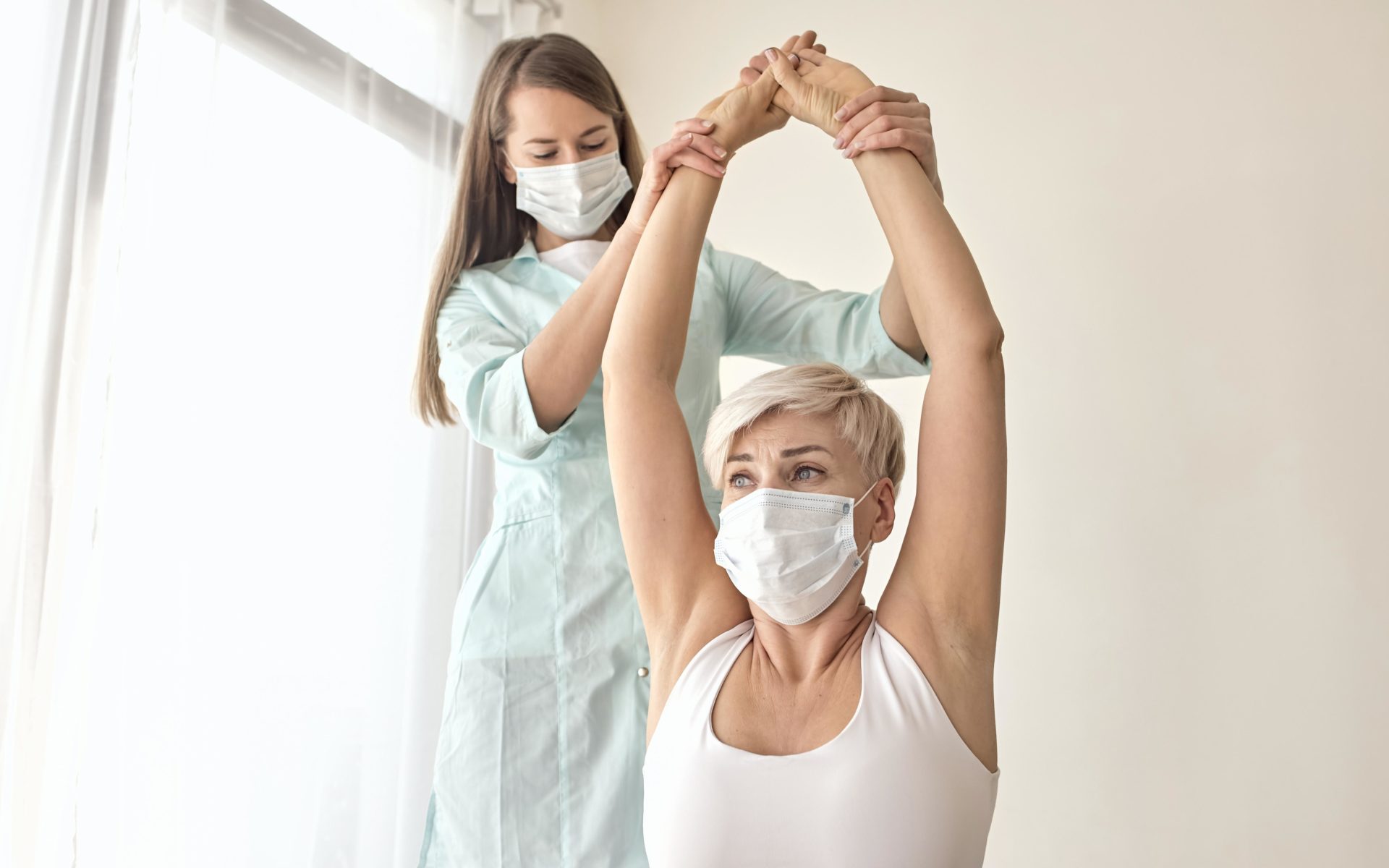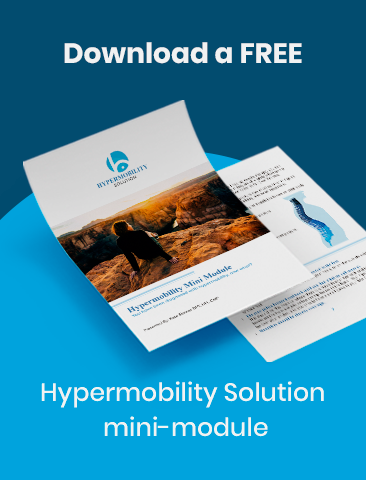If you’re suffering from debilitating hypermobility symptoms, read on to discover the causes and best treatment options for the top 10 most common symptoms of hypermobility syndrome.
Hypermobility syndrome is something many people have never heard of. They have no idea what it means.
Hypermobility simply means your joints are more flexible and have a wider range of motion than normal. In most cases, it causes no problems and presents no symptoms.
It’s pretty common, particularly in children and young people. Up to 15% of kids have hypermobile joints that usually tighten up to a normal range of motion as they get older.
But some people’s joints don’t tighten with age, which can cause a whole host of painful symptoms as they go through life.
Hypermobility syndrome is caused either by injury or by inherited genetic defects which negatively impact your body’s production of collagen.
Collagen is the “glue” that holds all our joints and tissues together. Three of the most serious causes of hypermobility are Ehlers-Danlos Syndrome (EDS), Marfan Syndrome (MFS), and Joint Hypermobility Syndrome (JHS).
All three present a cluster of hypermobility symptoms that range from mild to crippling. Some symptoms are common to all three, while others are more specific. Let’s take a look at each symptom in more detail.

Top 10 Most Common Symptoms of Hypermobility
Pain/stiffness in joints and muscles
If you have hypermobility syndrome, the joints most likely to hurt are your shoulders, knees, wrists, elbows, and fingers.
The body’s weakened collagen (due to genetic errors) means the connective tissue around your joints is too flexible and doesn’t hold them in place very well.
And your muscles have to work harder than normal to hold keep your joints stable, resulting in pain.
Headaches
Painful and recurrent headaches are a common symptom of hypermobility. Pain in the joints and muscles of your upper body, including your neck and shoulders, can result in severe headache pain that’s difficult to control.
Joints make cracking/popping sounds
Clicking joints are common in many people, even if they don’t have hypermobility syndrome. If you do have it, joint popping can be particularly loud and accompanied by pain.
Easy joint dislocation
Hypermobility sufferers are prone to easy dislocation of their joints. Dislocation means joints pop out of their sockets. This can cause you severe pain. Dislocation is especially common if you have Ehlers-Danlos Syndrome (EDS).
Fatigue/lack of energy
Chronic fatigue is symptomatic of many different diseases and disorders, including hypermobility syndrome. Pain and stiffness may result in poor sleep and tiredness.
The chronic, ongoing pain of hypermobility saps energy and motivation levels.
Frequent reoccurring injuries
Weak collagen throughout your body makes you more susceptible to injury, particularly injuries to your muscular-skeletal system. Sprains, dislocations, and muscle tears are more likely.
Digestive complaints like diarrhea, constipation, irritable bowel syndrome (IBS)
Hypermobility syndrome often comes with digestive disorders. It may lead to problems with hernias or other structural gut issues.
Malfunctions in the coordination of involuntary muscle movement within the gut are also common. This means food doesn’t properly move through your digestive tract, leading to irritable bowel syndrome (IBS) and acid reflux.
Stretchy/thin skin that’s fragile and easily injured
In some cases, hypermobility syndrome results in skin that’s thin, stretchy, or saggy. If you have very fragile skin, it’s more prone to trauma like bruises, cuts, and tearing. You may also scar easily, and your scars may never fade or heal properly.
Scoliosis
Scoliosis is a lateral curvature of the spine. Since your spine is a collection of joints, scoliosis due to hypermobility syndrome can wreak havoc on your spinal health.
Poor balance/co-ordination
Lax joints, weak connective tissue, and poor posture often cause balance and coordination problems in hypermobility syndrome.

Treatment Options for the Top 10 Most Common Symptoms of Hypermobility
Pain & stiffness
Hypermobile patients often need specific physical therapy that’s geared towards their condition. Standard types of PT can actually be harmful to you if you have hypermobility.
For example, over-stretching can make your condition worse. Hypermobile-specific treatment involves specific muscle strengthening, posture correction, and movement coordination exercises.
Headaches
Reducing your overall chronic pain is essential to resolving problem headaches. Physical therapy designed for hypermobility will also help with headache pain.
Cracking/popping joints
Hypermobile people often feel an excessive need to pop or “adjust” their joints. This can make the condition worse over time. The condition-specific treatment for pain mentioned above is the best way to reduce joint cracking and popping.
Dislocations
Dislocated joints are a serious problem. You should avoid any straining or injury to your joints. Your treatment specialist can also give you specific exercises you can do to strengthen the muscles that hold your joints in place.
Fatigue
Fatigue is a common symptom of hypermobility syndrome and can make it very hard to function sometimes.
The reduction of chronic pain is essential to increasing your energy levels. A healthy diet, regular and safe exercise and good sleep hygiene can also help in managing hypermobility-related fatigue.
Frequent injuries
Staying fit overall will reduce your chances of joint injury. Depending on the type of hypermobility you have, your doctor may prescribe braces for your joints to keep them safe and injury-free.
Digestive problems
Hypermobility often causes problems with the autonomic nervous system (dysautonomia), which controls your digestive functions.
There is no cure for dysautonomia, but it can be managed through a good diet, good sleep, therapy, and limiting sugar and caffeine intake.
Thin & fragile skin
Protecting your skin is critical – from injury, sun, scarring, etc. Make sure any skin or tissue infections are treated promptly and thoroughly.
Scoliosis
Your doctor may suggest bracing and/or surgery to treat your scoliosis. They will also perform a thorough health examination to make sure your scoliosis isn’t part of another underlying disease. Mild spine curvatures often don’t need treatment.
Balance and coordination issues
Your doctor may prescribe exercises that improve your balance and coordination. Additionally, improving your self-care and making positive lifestyle changes in sleep and diet may help.
Are You Struggling with Hypermobility Symptoms?
Many people like you have found their treatments didn’t really work for them. Check out our unique Hypermobility Solution now to learn how you can live pain-free.
Living with any of the top 10 most common symptoms of hypermobility syndrome can be utterly debilitating. Fortunately, new treatment options now exist that are giving people their lives back and allowing them to fully engage in life, symptom-free.




